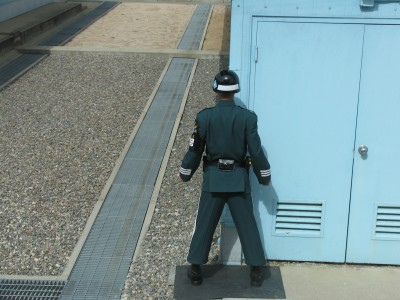Journeying to Korea’s Demilitarized Zone (DMZ)

Seoul.
Atrocity tourism and what might be termed the tourism of divisive obstacles (fences, barbed wire, mine fields) can be great money earners. Former concentration and extermination camps in Europe bring in currency even as visitors shake with stunned grief and moral disturbance – tears and foreboding as valuable currency.
In South Korea, the money earner is the Demilitarised Zone, shortened to the seemingly innocuous DMZ. Euphemised in such a manner, and one can forget the tens of thousands of helmeted men who gaze at each other at border points, or the thousands of artillery pieces in concealed spaces waiting to be deployed in a moment of annihilating fury.
Gazing across a territory with millions of unexploded mines, a territory that, ironically enough, is meant to be demilitarised, chills the blood. Here, along the 38th parallel, another legacy of great power cruelty and avarice, two Koreas face each other on one of the most heavily armed borders on the planet. This may be the site of the next regional, or world war, one that promises to be over with apocalyptic brevity.
Time and history are suspended here, a form of cryogenic storage. There are monuments to the signing of the armistice that never formally concluded the war of 1950-1953. There are scrap items such as shot up trains gloomily present in rusty solemnity. A crisp, biting air adds to the atmosphere as the field glasses are deployed across from the Dora observatory. Birds of prey hover over an area teaming with ornithological variety, and seem indifferent, or certainly acclimatised to the megaphone music blaring across the border. Two enormous flagpoles gaze at each other, accompanying flags limp.
Kaesong City can be seen from Mount Dora. To the left, is something that could hardly count as a village.
“If you look to the left, it is a fake city,” points the guide Han.
That purports to be “Propaganda Village” or Kijong-dong, supposedly an incentive to lure those in the South who have had enough, and wish for the offerings of the north.
The guide is intent on educating his guests. In the manner of an overly enthusiastic master, he wishes to dictate things early.
“You will all be known as Han’s guests.”
He insists, with a weak stab at humour, on being called Han, or, should you wish, Han Solo. If all things fail, he will settle with Rob.
As we make our way to the DMZ, Han feels obligated to regale us with stories punctuated by trivia. In time, he starts to ramble, even prattle. His points of discussion are suitably packaged for morsel-sized consumption, directed at social media junkies rather than bookish types. These are not visitors who are too aware of their history, offering easy pickings.
He describes the situation for defectors, most of who come through China rather than brave the murderous parallel. They are offered assistance and programs to integrate into South Korean society, though these are, in the scheme of things, modest. The arms might be open in welcome, but these are only ever at half-stretch. The citizens of the DPRK remain, at best, second in the political and social lottery.
To the border, moments of absurd optimism are presented. What promises to be an international station at Dorasan, a potential future meeting point on the way to Pyongyang, is heralded as another hopeful sign. We do not know when, but the sense here is that the train service to the DPRK will commence, a state of affairs that will link the Koreas to lucrative trans-continental train lines, including the Trans-Siberian.
“Not the last station from the South,” comes the advertisement, “But the first station toward the North.”
Even across the unpromising barbed wire, the frosty gazes, the lethal defences, Han is confident: “Eventually, we are all going to be re-unified.” At the station entrance is yet another installation to press home the point: a piano for reunification with its strings replaced by barbed wire.
The absurdity does not stop there. Infiltration tunnels provide visitors a glimpse into the efforts of North Korean burrowers to find means of penetrating South Korean territory, though suggestions that these might be used in the event of an invasion are simply not convincing. For one thing, they are squat, narrow constructions that would only be suitable for an army of malnourished midgets on a suicide mission. An Indonesian lady, burnished with a hard hat, barely grazes the top. Taller visitors are not so lucky, and helmets crash and graze the tunnel as the claustrophobia sets in.
A few beat a hasty retreat on initially seeing the 263 metres before them. To get to that tunnel requires traversing another dug entrance. “Too crazy, too hot,” comes the surrendering lament of a thick set Indian man. The walls, covered in coal glazing to give the impression of a legitimate mining venture, seem to be moving in; the back begins to ache, the muscles to tighten.
The tourist spectacle resolves itself in being stark, though, in anticipation of US tourists, take away coffee options are plentiful at meeting points through the DMZ tour. The knickknacks are poor in variety. Ginseng brandy from North Korea is available for purchase, as are a range of trashy trinkets reflecting the parlous state of border relations.
On the return to Itaewon, the guide makes a modest effort to rein in his enthusiasm. He decides the visitors to go to the amethyst factory, promoting the magic of Korea’s national stone. The employees at the factory pounce with unremitting fury, hoping to make a killing. Some succeed. Han Solo-Rob looks pleased. Even in the shade of potential, existentially harmful conflict, business will go on as the Koreas continue, to a large extent, to remain ghosts at the feast of power politics.
Dr. Binoy Kampmark was a Commonwealth Scholar at Selwyn College, Cambridge. He lectures at RMIT University, Melbourne. Email: [email protected]

